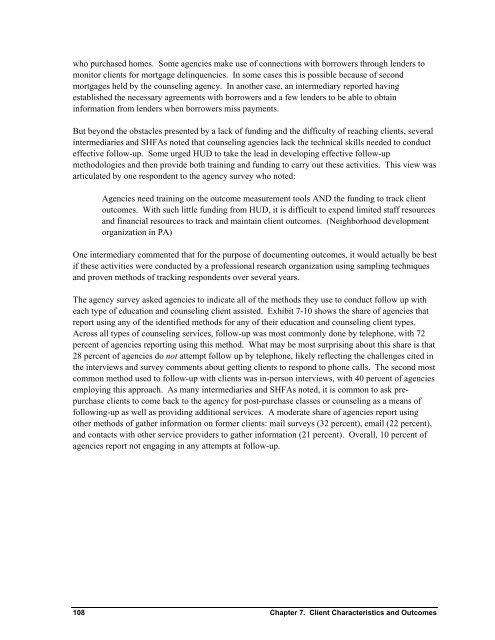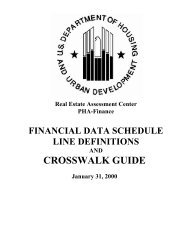Housing Counseling Process Evaluation and Design of ... - HUD User
Housing Counseling Process Evaluation and Design of ... - HUD User
Housing Counseling Process Evaluation and Design of ... - HUD User
Create successful ePaper yourself
Turn your PDF publications into a flip-book with our unique Google optimized e-Paper software.
who purchased homes. Some agencies make use <strong>of</strong> connections with borrowers through lenders to<br />
monitor clients for mortgage delinquencies. In some cases this is possible because <strong>of</strong> second<br />
mortgages held by the counseling agency. In another case, an intermediary reported having<br />
established the necessary agreements with borrowers <strong>and</strong> a few lenders to be able to obtain<br />
information from lenders when borrowers miss payments.<br />
But beyond the obstacles presented by a lack <strong>of</strong> funding <strong>and</strong> the difficulty <strong>of</strong> reaching clients, several<br />
intermediaries <strong>and</strong> SHFAs noted that counseling agencies lack the technical skills needed to conduct<br />
effective follow-up. Some urged <strong>HUD</strong> to take the lead in developing effective follow-up<br />
methodologies <strong>and</strong> then provide both training <strong>and</strong> funding to carry out these activities. This view was<br />
articulated by one respondent to the agency survey who noted:<br />
Agencies need training on the outcome measurement tools AND the funding to track client<br />
outcomes. With such little funding from <strong>HUD</strong>, it is difficult to expend limited staff resources<br />
<strong>and</strong> financial resources to track <strong>and</strong> maintain client outcomes. (Neighborhood development<br />
organization in PA)<br />
One intermediary commented that for the purpose <strong>of</strong> documenting outcomes, it would actually be best<br />
if these activities were conducted by a pr<strong>of</strong>essional research organization using sampling techniques<br />
<strong>and</strong> proven methods <strong>of</strong> tracking respondents over several years.<br />
The agency survey asked agencies to indicate all <strong>of</strong> the methods they use to conduct follow up with<br />
each type <strong>of</strong> education <strong>and</strong> counseling client assisted. Exhibit 7-10 shows the share <strong>of</strong> agencies that<br />
report using any <strong>of</strong> the identified methods for any <strong>of</strong> their education <strong>and</strong> counseling client types.<br />
Across all types <strong>of</strong> counseling services, follow-up was most commonly done by telephone, with 72<br />
percent <strong>of</strong> agencies reporting using this method. What may be most surprising about this share is that<br />
28 percent <strong>of</strong> agencies do not attempt follow up by telephone, likely reflecting the challenges cited in<br />
the interviews <strong>and</strong> survey comments about getting clients to respond to phone calls. The second most<br />
common method used to follow-up with clients was in-person interviews, with 40 percent <strong>of</strong> agencies<br />
employing this approach. As many intermediaries <strong>and</strong> SHFAs noted, it is common to ask prepurchase<br />
clients to come back to the agency for post-purchase classes or counseling as a means <strong>of</strong><br />
following-up as well as providing additional services. A moderate share <strong>of</strong> agencies report using<br />
other methods <strong>of</strong> gather information on former clients: mail surveys (32 percent), email (22 percent),<br />
<strong>and</strong> contacts with other service providers to gather information (21 percent). Overall, 10 percent <strong>of</strong><br />
agencies report not engaging in any attempts at follow-up.<br />
108<br />
Chapter 7. Client Characteristics <strong>and</strong> Outcomes
















